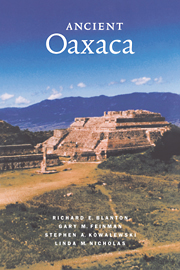Book contents
3 - The origins of Monte Albán
Published online by Cambridge University Press: 05 June 2012
Summary
Just after 500 B.C. pottery makers in the Valley of Oaxaca modified many of the ceramic types they had fashioned during what we call the Rosario phase and began making a number of distinctive kinds of pottery vessels (box 5). This ceramic change permits today's archaeologists to identify and distinguish sites of the ceramic phase that follows Rosario, Monte Albán Early I (500–300 B.C.) – the first phase of a period that extended to 100 B.C. A period called “I” occurs so late in the valley's ceramic sequence, nearly one thousand years later than the appearance of the earliest pottery, because the first stratigraphic excavations in the valley were conducted at Monte Albán, a site whose history commenced around 500 B.C. The pottery found in the lowest stratigraphic levels (Period I) was assumed to be the earliest in the valley. As illustrated in the previous chapter, subsequent research at more ancient sites such as San José Mogote found several pre-Monte Albán phases, but we still use the terminology of the Monte Albán ceramic sequence.
The social and cultural changes that began during Early I and continued into Late I were epochal ones in the valley's history; they are felt in many respects right up to the present day. Not all aspects of these changes can be described as thoroughly as we would like, because most of the Oaxacan archaeological record is still unexplored. Yet various lines of archaeological and epigraphic evidence point to a profound transformation of society, technology, and culture.
- Type
- Chapter
- Information
- Ancient Oaxaca , pp. 48 - 67Publisher: Cambridge University PressPrint publication year: 1999

